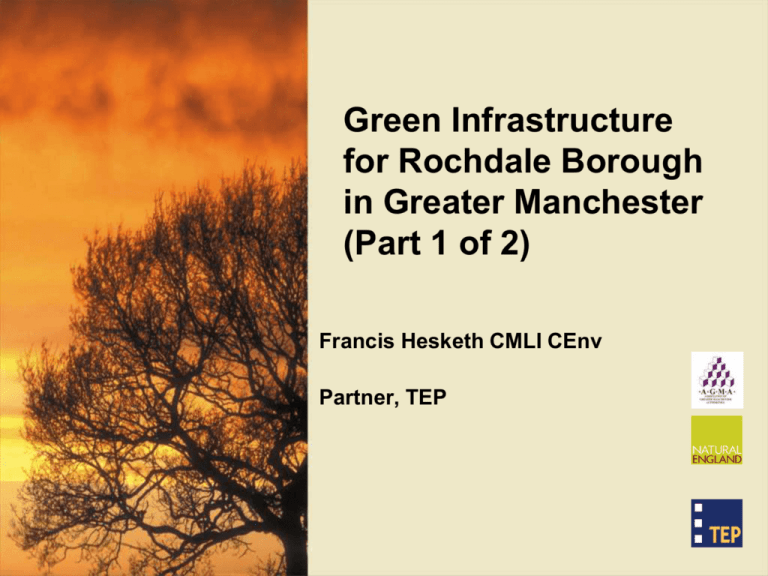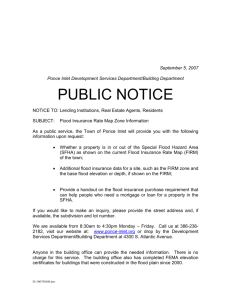Green Infrastructure
advertisement

Green Infrastructure for Rochdale Borough in Greater Manchester (Part 1 of 2) Francis Hesketh CMLI CEnv Partner, TEP Study Objectives: 1. What does Green Infrastructure mean for Greater Manchester? 2. “Route-map” for the City Region to implement GI Why? • We have to (policy obligation in RSS and NGP) • We need to (to effectively deliver key functions & deal with growth blockers (MAA & GM Strategic Plan)) • The “2025 world-class city” vision requires a collaborative approach to GI • Case studies elsewhere e.g. London / New York emphasise that partnership working is critical – “Its Infrastructure, Stupid!” We will make our cities sustainable by a few major projects and a thousand and one small changes From Low S. Sustainable Cities Image © CABE “Growth-support” functions of Green Infrastructure in GM 1. Flood risk management & climate change adaptation 2. Ecological framework 3. Sustainable movement (multi-user routes) 4. Sense of place 5. River & canal corridor management 6. Positive image & setting for growth 7. Supporting urban regeneration 8. Supporting communities, health and enjoyment Jobs & Prosperity Tourism, Leisure, Image, Inward Investment, Gateways, Healthier workers, Flood-proofing town centres Every Child Matters Healthier lifechoices, Sport, Environmental Education Community Safety Healthier communities, more volunteers, better looked-after places Cleaner Greener Environment Parks & Open Spaces, Access to the Countryside,Volunteering, Biodiversity, Landscape Quality Health & Wellbeing Sport, Leisure, Mental Stress relief PLACE LIFE Quality ENVIRONMENT Case study 1: River Quaggy, Lewisham, London • River flows 35% in culvert, 39% in “concrete canal” • Flooding affected development potential and land values downstream • Lewisham Town Centre vulnerable • Traditional engineered solutions to flood defence required maintenance and had delivered one function at the expense of many others • Local revolt against engineered solutions – Quaagy Waterways Action Group Case study 1: River Quaggy, Lewisham, London • Sutcliffe Park was a “typical green desert” park – Quaggy flowed in culvert underneath • Regeneration and health issues • QWAG /Environment Agency used Flood alleviation scheme money to create flood storage washlands in Sutcliffe Park instead Left: 2003 before restoration Below: 2004, then 2007 Economic Benefits: Lower cost flood defences. More flood storage. Increased development potential and town centre flood-proofing Health Benefits: More use of park: Biodiversity Benefits: Community Cohesion Benefits: Active Civic group Regional Centre and Inner Areas East London Green Grid River Quaggy Regional Park Opportunity Regional Centre & Inner Areas Case study A: Pennine Edge Forest • Belfield Urban Forest was underused greenspace in the River Roch Valley • Close to HMR area and existing deprived communities • NEWLANDS and SUSTRANS schemes • January 2008 flood storage protected town centre Case study A: Pennine Edge Forest • Natural Signposting Project in Kirkholt (interwar estate with over supply of green space) • Connections to Rochdale Canal & Tandle Hill Park • South Rochdale Forest Trail Transforming Estates Priory Green (Peabody Trust, London) Case study B: Irwell Valley • M62 • DUN Land, • Flood Issues • Biodiversity & Cultural Heritage • Deprivation Issues • Close to HMR / Growth Point Case study B: Irwell Valley Case study C: Littleton Road Playing Fields – Flood Attenuation Basin in the Irwell Valley, Salford • Existing Playing Fields • Flood bunds and environmental improvements • 1:75 Flood risk protection to Housing market Renewal Area • January 2008 floods – the basin protected 6500 homes • Increase in investor confidence Case study D: Irwell City Park • Cross-boundary (Salford, Trafford, Manchester) • Environmental and waterfront improvements • New leisure, tourism and business destination • GI delivered thro’ public realm/ greenstreets/ new waterside access • Contiguous with Croal Irwell Regional Park • Strong brand attractive to investors • Good delivery model







